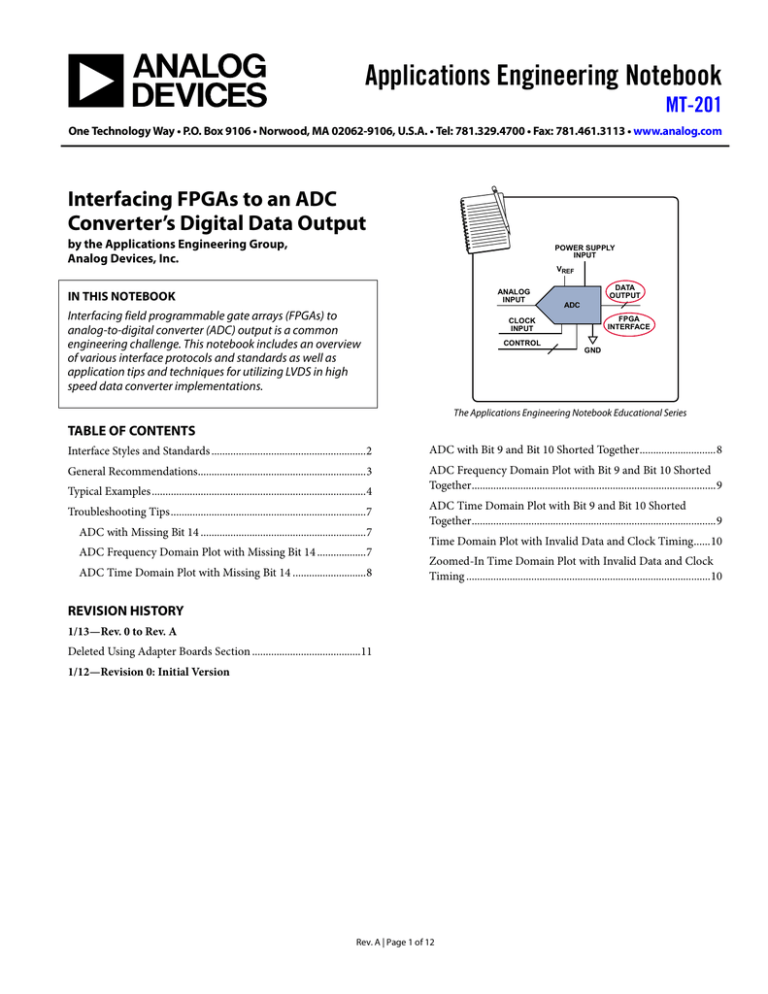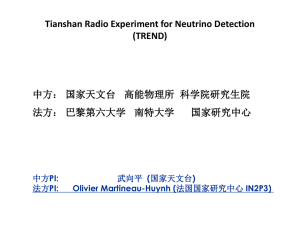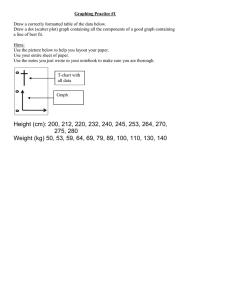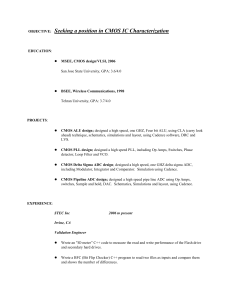Applications Engineering Notebook MT-201
advertisement

Applications Engineering Notebook MT-201 One Technology Way • P.O. Box 9106 • Norwood, MA 02062-9106, U.S.A. • Tel: 781.329.4700 • Fax: 781.461.3113 • www.analog.com Interfacing FPGAs to an ADC Converter’s Digital Data Output by the Applications Engineering Group, Analog Devices, Inc. POWER SUPPLY INPUT VREF ANALOG INPUT IN THIS NOTEBOOK Interfacing field programmable gate arrays (FPGAs) to analog-to-digital converter (ADC) output is a common engineering challenge. This notebook includes an overview of various interface protocols and standards as well as application tips and techniques for utilizing LVDS in high speed data converter implementations. DATA OUTPUT ADC FPGA INTERFACE CLOCK INPUT CONTROL GND The Applications Engineering Notebook Educational Series TABLE OF CONTENTS Interface Styles and Standards .........................................................2 ADC with Bit 9 and Bit 10 Shorted Together ............................ 8 General Recommendations..............................................................3 ADC Frequency Domain Plot with Bit 9 and Bit 10 Shorted Together.......................................................................................... 9 Typical Examples ...............................................................................4 Troubleshooting Tips ........................................................................7 ADC with Missing Bit 14 .............................................................7 ADC Frequency Domain Plot with Missing Bit 14 .................. 7 ADC Time Domain Plot with Missing Bit 14 ........................... 8 ADC Time Domain Plot with Bit 9 and Bit 10 Shorted Together.......................................................................................... 9 Time Domain Plot with Invalid Data and Clock Timing ...... 10 Zoomed-In Time Domain Plot with Invalid Data and Clock Timing .......................................................................................... 10 REVISION HISTORY 1/13—Rev. 0 to Rev. A Deleted Using Adapter Boards Section ........................................11 1/12—Revision 0: Initial Version Rev. A | Page 1 of 12 MT-201 Applications Engineering Notebook INTERFACE STYLES AND STANDARDS Interfacing field programmable gate arrays (FPGAs) to analogto-digital converter (ADC) digital data output is a common engineering challenge. The task is complicated by the fact that ADCs use a variety of digital data styles and standards. Single data rate (SDR) CMOS is very common for lower speed data interfaces, typically under 200 MHz. In this case, data is transitioned on one edge of the clock by the transmitter and received by the receiver on the other clock edge. This ensures the data has plenty of time to settle before being sampled by the receiver. In double data rate (DDR) CMOS, the transmitter transitions data on every clock edge. This allows for twice as much data to be transferred in the same amount of time as SDR; however, the timing for proper sampling by the receiver is more complicated. Parallel low voltage differential signaling (LVDS) is a common standard for high speed data converters. It uses differential signaling with a P and N wire for each bit to achieve speeds up to the range of 1.6 Gbps with DDR or 800 MHz in the latest FPGAs. Parallel LVDS consumes less power than CMOS, but requires twice the number of wires, which can make routing difficult. Though not part of the LVDS standard, LVDS is commonly used in data converters with a “source synchronous” clocking system. In this setup, a clock, which is in-phase with the data, is transmitted alongside the data. The receiver can then use this clock to capture the data easier, since it now knows the data transitions. FPGA logic is often not fast enough to keep up with the bus speed of high speed converters, so most FPGAs have serializer/deserializer (SERDES) blocks to convert a fast, narrow serial interface on the converter side to a wide, slow parallel interface on the FPGA side. For each data bit in the bus, this block outputs 2, 4, or 8 bits, but at ½, ¼, or 1/8 the clock rate, effectively deserializing the data. The data is processed by wide busses inside the FPGA that run at much slower speeds than the narrow bus going to the converter. The LVDS signaling standard is also used in serial links, mostly on high speed ADCs. Serial LVDS is typically used when pin count is more important than interface speed. Two clocks, the data rate clock and the frame clock, are often used. All the considerations mentioned in the parallel LVDS section also apply to serial LVDS. Parallel LVDS simply consists of multiple serial LVDS lines. I2C uses two wires: clock and data. It supports a large number of devices on the bus without additional pins. I2C is relatively slow, 400 kHz to 1 MHz with protocol overhead. It is commonly used on slow devices where part size is a concern. I2C is also often used as a control interface or data interface. SPI uses 3 or 4 wires: • • • Clock Data in and data out (4-wire), or bidirectional data in/data out (3-wire) Chip select (one per nonmaster device) SPI supports as many devices as the number of available chip select lines. It provides speeds up to about 100 MHz and is commonly used as both a control interface and data interface. Serial PORT (SPORT), a CMOS-based bidirectional interface, uses one or two data pins per direction. Its adjustable word length provides better efficiency for non %8 resolutions. SPORT offers time domain multiplexing (TDM) support and is commonly used on audio/media converters and high channel count converters. It offers performance of about 100 MHz per pin. SPORT is supported on Blackfin processors and offers straightforward implementation on FPGAs. SPORT is generally used for data only, although control characters can be inserted. JESD204 is a JEDEC standard for high speed serial links between a single host, such as an FPGA or ASIC, and one or more data converters. The latest spec provides up to 3.125 Gbps per lane or differential pair. Future revisions may specify 6.25 Gbps and above. The lanes use 8B/10B encoding, reducing effective bandwidth of the lane to 80% of the theoretical value. The clock is embedded in data stream so there are no extra clock signals. Multiple lanes can be bonded together to increase throughput while the data link layer protocol ensures data integrity. JESD204 requires significantly more resources in FPGA/ASIC for data framing than simple LVDS or CMOS. It dramatically reduces wiring requirements at the expense of a more expensive FPGA and more sophisticated PCB routing. FPGA CONVERTER 75MHz ×128 BITS SERDES ×16 600MHz ×16 BITS 10339-017 FPGA LOGIC Figure 1. SERDES Blocks in FPGA Interface with High Speed Serial Interfaces on Converter Rev. A | Page 2 of 12 Applications Engineering Notebook MT-201 GENERAL RECOMMENDATIONS VDD Some general recommendations are helpful in interfacing between ADCs and FPGAs. • • • Use external resistor terminations at the receiver, FPGA, or ASIC, rather than the internal FPGA terminations, to avoid reflections due to mismatch that can break the timing budget. Don’t use one DCO from one ADC if you are using multiple ADCs in the system. Don’t use a lot of “tromboning” when laying out digital traces to the receiver to keep all traces equal length. Use series terminations on CMOS outputs to slow edge rates down and limit switching noise. Verify that the right data format (twos complement, offset binary) is being used. With single-ended CMOS digital signals, logic levels move at about 1 V/nS, typical output loading is 10 pF maximum, and typical charging currents are 10 mA/bit. Charging current should be minimized by using the smallest capacitive load possible. This can usually be accomplished by driving only one gate with the shortest trace possible, preferably without any vias. Charging current can also be minimized by using a damping resistor in digital outputs and inputs. PMOS dV dt i=C NMOS i dV dt C EXTERNAL LOAD 10339-002 • Figure 2. Typical CMOS Digital Output Drivers ADC digital outputs should be treated with care because transient currents can increase the noise and distortion of the ADC by coupling back into the analog input. Typical CMOS drivers shown in Figure 2 are capable of generating large transient currents, especially when driving capacitive loads. Particular care must be taken with CMOS data output ADCs so that these currents are minimized and do not generate additional noise and distortion in the ADC. The time constant of the damping resistor and the capacitive load should be approximately 10% of the period of the sample rate. If the clock rate is 100 MHz and the loading is 10 pF, then the time constant should be 10% of 10 nS or 1 nS. In this case, R should be 100 Ω. For optimal signal-to-noise ratio (SNR) performance, a 1.8 V DRVDD is preferred over 3.3 V DRVDD. However, SNR is degraded when driving large capacitive loads. CMOS outputs are useable up to about 200 MHz sampling clocks. If driving two output loads or trace length is longer than 1 or 2 inches, a buffer is recommended. Rev. A | Page 3 of 12 MT-201 Applications Engineering Notebook TYPICAL EXAMPLES ANALOG INPUT dV = 1V/ns dt GENERATES 10mA/BIT CHARGING CURRENT WHEN DRIVING 10pF DIRECTLY the data output be connected directly to a noisy data bus. An intermediate buffer register must be used to minimize direct loading of the ADC outputs. R ADC WITH CMOS OUTPUTS N BITS OUTPUT DRIVER VDD C = 10pF 1 Q1 fS 10339-003 MAKE RC < 0.1 FOR fS = 100MSPS, RC < 1ns IF C = 10pF, R = 100Ω The total transient current for the 16-bit ADC can, therefore, be as high as 16 × 10 mA = 160 mA. These transient currents can be suppressed by adding a small resistor, R, in series with each data output. The value of the resistor should be chosen so that the RC time constant is less than 10% of the total sampling period. For fs = 100 MSPS, RC should be less than 1 ns. With C = 10 pF, an R of about 100 Ω is optimum. Choosing larger values of R can degrade output data settling time and interfere with proper data capture. Capacitive loading on CMOS ADC outputs should be limited to a single gate load, usually an external data capture register. Under no circumstances should V– V+ 350mV Q2 A– 100Ω R TERM A+ Z0 = 50 +1.2V V+ 3.5kΩ 3.5kΩ Figure 3. Use Series Resistance to Minimize Charging Current of CMOS Digital Outputs Figure 3 shows the case of a 16-bit parallel CMOS output ADC. With a 10 pF load on each output, simulating one gate load plus PCB parasitics, each driver generates a charging current of 10 mA when driving a 10 pF load. V– ~1.2V IS T (3.5mA) SIMULATES 1 GATE LOAD PLUS PCB PARASITICS V+ LVDS RECEIVER Z0 = 50 Q3 V– Q4 A+ A– LVDS OUTPUT – CONSTANT CURRENT OUTPUT MINIMIZES COUPLING EFFECT IS B (3.5mA) Figure 4. Typical LVDS Driver Design Figure 4 shows a standard LVDS driver in CMOS. The nominal current is 3.5 mA and the common-mode voltage is 1.2 V. The swing on each input at the receiver is therefore 350 mV p-p when driving a 100 Ω differential termination resistor. This corresponds to a differential swing of 700 mV p-p. These figures are derived from the LVDS specification. Rev. A | Page 4 of 12 10339-004 fS ULS: 10000/15600 0 –500 TIE JITTER HISTOGRAM (Hits) –1ns –0.5ns 0ns 0.5ns –200 –1ns 50 0ns 100ps ULS: 10000/15596 0 1ns 100 0 –100ps EYE: ALL BITS 200 –0.5ns 0ns 0.5ns 1ns SMALLER OUTPUT SWING = SAVE POWER: ~30mW AT 40MSPS TO 65MSPS 100 50 0 –100ps DATA EYE FOR LVDS OUTPUTS IN ANSI MODE WITH TRACE LENGTHS LESS THAN 12 INCHES ON STANDARD FR-4 0ns 100ps DATA EYE FOR LVDS OUTPUTS IN IEEE MODE WITH TRACE LENGTHS LESS THAN 12 INCHES ON STANDARD FR-4 10339-005 EYE: ALL BITS EYE DIAGRAM VOLTAGE (mV) 500 MT-201 TIE JITTER HISTOGRAM (Hits) EYE DIAGRAM VOLTAGE (mV) Applications Engineering Notebook Figure 5. ANSI vs. IEEE LVDS Standards EYE: ALL BITS ULS: 9600/15600 200 0 –200 –1ns –0.5ns 0ns 0.5ns EYE DIAGRAM VOLTAGE (mV) EYE DIAGRAM VOLTAGE (mV) There are two LVDS standards: one is defined by ANSI and the other by IEEE. While the two standards are similar and generally compatible with each other, they are not identical. Figure 5 compares an eye diagram and jitter histogram for each of the two standards. IEEE standard LVDS has a reduced swing of 200 mV p-p as compared to the ANSI standard of 320 mV p-p. This helps to save power on the digital outputs. For this reason, use the IEEE standard if it will accommodate the application and connections that need to be made to the receiver. 400 EYE: ALL BITS ULS: 9599/15599 200 0 –200 –400 –1ns 1ns –0.5ns 0ns 0.5ns 1ns SMALLER OUTPUT SWING = SAVE POWER: ~30mW AT 40MSPS TO 65MSPS 50 0 –150ps –100ps –50ps 0ns 50ns 100ns 150ps DATA EYE FOR LVDS OUTPUTS IN ANSI MODE WITH TRACE LENGTHS GREATER THAN 12 INCHES ON STANDARD FR-4 100 50 0 –150ps –100ps –50ps 0ns 50ns 100ns 150ps DATA EYE FOR LVDS OUTPUTS IN ANSI MODE, WITH DOUBLE CURRENT ON, TRACE LENGTHS GREATER THAN 12 INCHES ON STANDARD FR-4 10339-006 TIE JITTER HISTOGRAM (Hits) TIE JITTER HISTOGRAM (Hits) 100 Figure 6. ANSI vs. IEEE LVDS Standards with Traces over 12 Inches Figure 6 compares the ANSI and IEEE LVDS standards with long trace lengths above 12 inches or 30 cm. Both graphs are driven at the ANSI version standard. In the graph on the right, the output current is doubled. Doubling the output current cleans up the eye and improves the jitter histogram. Rev. A | Page 5 of 12 Applications Engineering Notebook 3.25Gbps – IDEAL SOURCE 3.25Gbps – AFTER 40 INCH FR4 10339-007 MT-201 Figure 7. Effects of FR4 Channel Loss Note the effects of a long trace on FR4 material in Figure 7. The left plot shows an ideal eye diagram, right at the transmitter. At the receiver, 40 inches away, the eye has almost closed and the receiver has difficulty recovering the data. Rev. A | Page 6 of 12 Applications Engineering Notebook MT-201 TROUBLESHOOTING TIPS 10339-008 ADC WITH MISSING BIT 14 Figure 8. AD9268 ADC with Missing Bit 14 In Figure 8, a VisualAnalog digital display of the data bits shows that Bit 14 never toggles. This could indicate an issue with the part, the PCB, the receiver, or, that the unsigned data simply is not large enough to toggle the most significant bit. 10339-009 ADC FREQUENCY DOMAIN PLOT WITH MISSING BIT 14 Figure 9. AD9268 ADC Frequency Domain Plot with Missing Bit 14 Figure 9 shows a frequency domain view of the previous digital data where Bit 14 is not toggling. The plot shows that the bit is significant and there is an error somewhere in the system. Rev. A | Page 7 of 12 MT-201 Applications Engineering Notebook 10339-010 ADC TIME DOMAIN PLOT WITH MISSING BIT 14 Figure 10. AD9268 ADC Time Domain Plot with Missing Bit 14 Figure 10 is a time domain plot of the same data. Instead of a smooth sine wave, the data is offset and has significant peaks at points throughout the waveform. 10339-011 ADC WITH BIT 9 AND BIT 10 SHORTED TOGETHER Figure 11. AD9268 ADC with Bit 9 and Bit 10 Shorted Together In Figure 11, instead of missing a bit, two bits are shorted together so that the receiver always sees the same data on the two pins. Rev. A | Page 8 of 12 Applications Engineering Notebook MT-201 10339-012 ADC FREQUENCY DOMAIN PLOT WITH BIT 9 AND BIT 10 SHORTED TOGETHER Figure 12. AD9268 ADC Frequency Domain Plot with Bit 9 and Bit 10 Shorted Together Figure 12 shows a frequency domain view of the same case where two bits are shorted together. While the fundamental tone is clearly present, the noise floor is significantly worse than it should be. The degree to which the floor is distorted depends on which bits are shorted. 10339-013 ADC TIME DOMAIN PLOT WITH BIT 9 AND BIT 10 SHORTED TOGETHER Figure 13. AD9268 ADC Time Domain Plot with Bit 9 and Bit 10 Shorted Together In this time-domain view shown in Figure 13, the issue is less obvious. Although some smoothness is lost in the peaks and valleys of the wave, this is also common when the sample rate is close to the waveform’s frequency. Rev. A | Page 9 of 12 MT-201 Applications Engineering Notebook 10339-014 TIME DOMAIN PLOT WITH INVALID DATA AND CLOCK TIMING Figure 14. AD9268 Time Domain Plot with Invalid Data and Clock Timing Figure 14 shows a converter with invalid timing, in this case caused by setup/hold problems. Unlike the previous errors, which generally showed themselves during each cycle of the data, timing errors are usually less consistent. Less severe timing errors may be intermittent. These plots show the time domain and frequency domain of a data capture that is not meeting timing. Notice that the errors in the time domain are not consistent between cycles. Also, note the elevated noise floor in the FFT/frequency domain. This usually indicates a missing bit, which can be caused by incorrect time alignment. 10339-015 ZOOMED-IN TIME DOMAIN PLOT WITH INVALID DATA AND CLOCK TIMING Figure 15. AD9268 Zoom-In Time Domain Plot with Invalid Data and Clock Timing Figure 15 is a closer view of the time domain timing error shown in the Figure 14. Again, note that the errors are not consistent from cycle to cycle, but that certain errors do repeat. An example is the negative spike on the valley of several cycles in this plot. Rev. A | Page 10 of 12 Applications Engineering Notebook MT-201 NOTES Rev. A | Page 11 of 12 MT-201 Applications Engineering Notebook NOTES ©2012–2013 Analog Devices, Inc. All rights reserved. Trademarks and registered trademarks are the property of their respective owners. MT10339-0-1/13(A) Rev. A | Page 12 of 12





